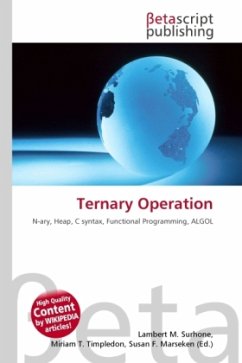
Ternary Operation
Versandkostenfrei!
Versandfertig in 6-10 Tagen
23,99 €
inkl. MwSt.

PAYBACK Punkte
12 °P sammeln!
High Quality Content by WIKIPEDIA articles! In mathematics, a ternary operation is an n-ary operation with n = 3. A ternary operation on a set A takes any given three elements of A and combines them to form a single element of A. An example of a ternary operation is the product in a heap. In computer science a ternary operator (sometimes incorrectly called a tertiary operator) is an operator that takes three arguments. The arguments and result can be of different types. Many programming languages that use C-like syntax feature a ternary operator, ?:, which defines a conditional expression. Sin...
High Quality Content by WIKIPEDIA articles! In mathematics, a ternary operation is an n-ary operation with n = 3. A ternary operation on a set A takes any given three elements of A and combines them to form a single element of A. An example of a ternary operation is the product in a heap. In computer science a ternary operator (sometimes incorrectly called a tertiary operator) is an operator that takes three arguments. The arguments and result can be of different types. Many programming languages that use C-like syntax feature a ternary operator, ?:, which defines a conditional expression. Since this operator is often the only existing ternary operator in the language, it is sometimes simply referred to as "the ternary operator".












